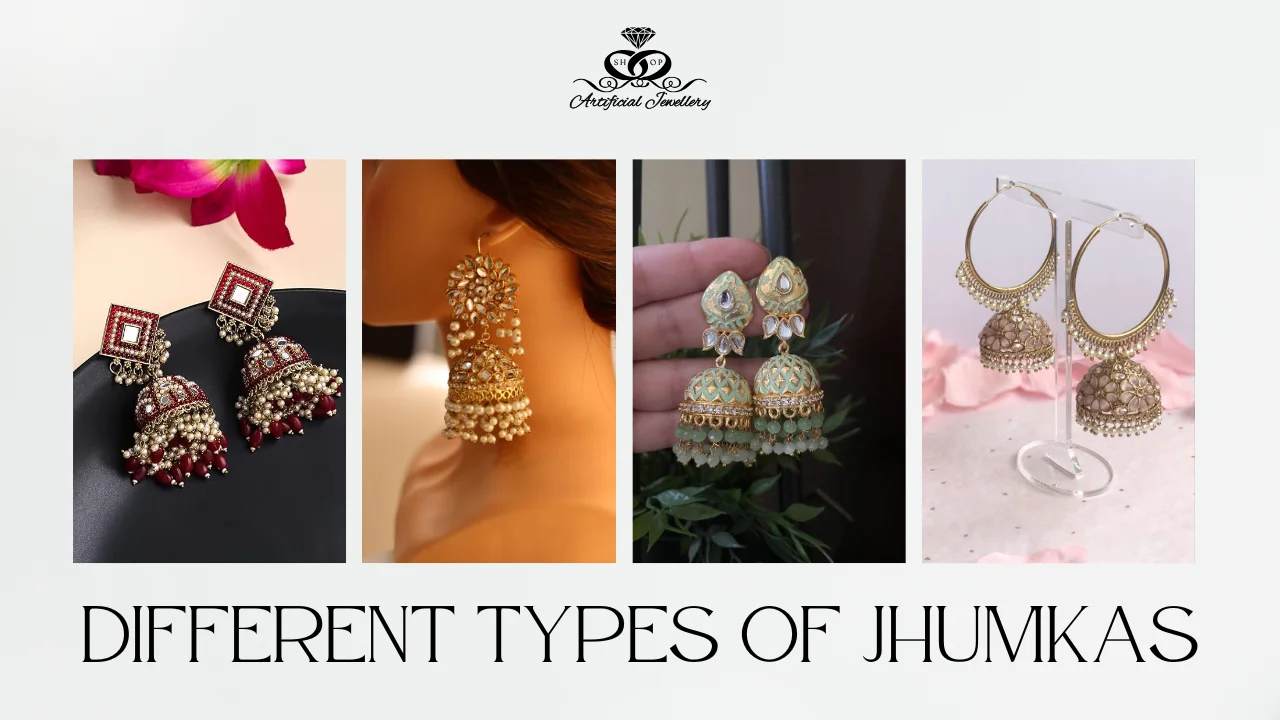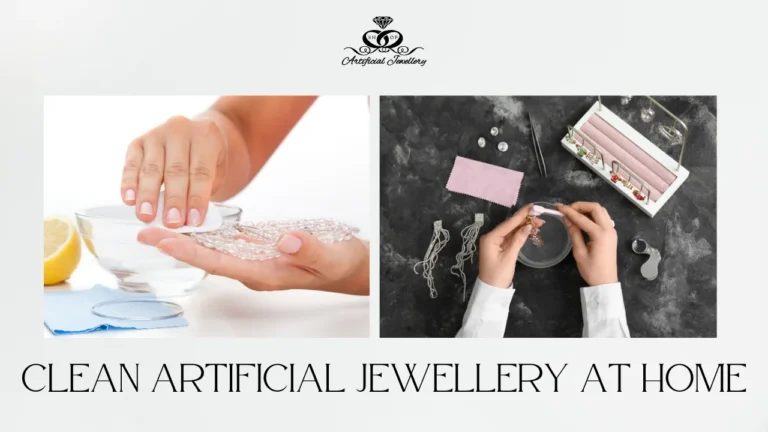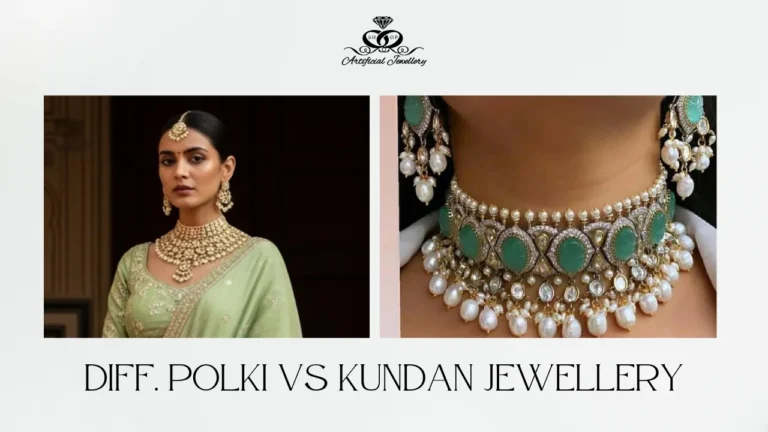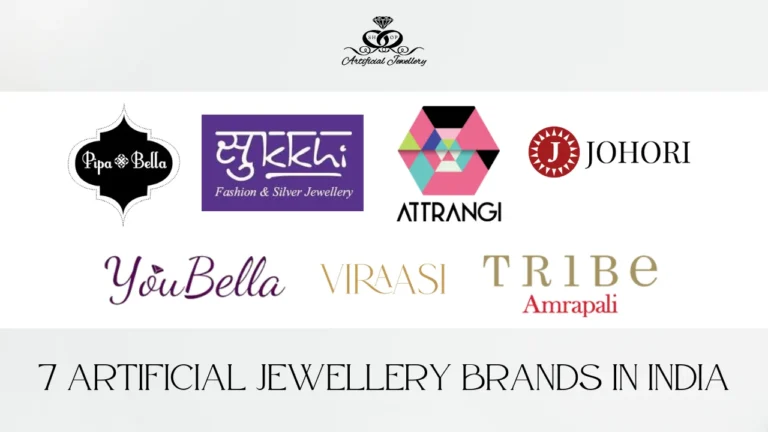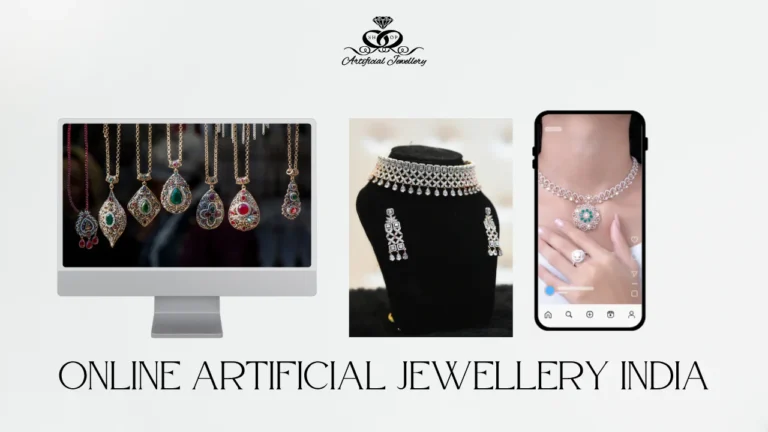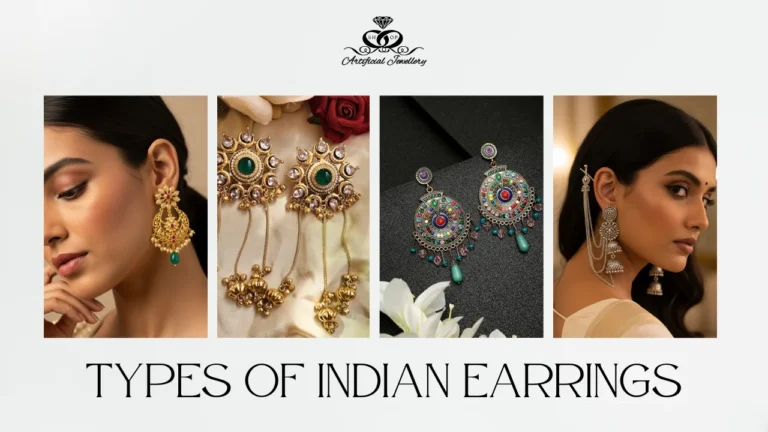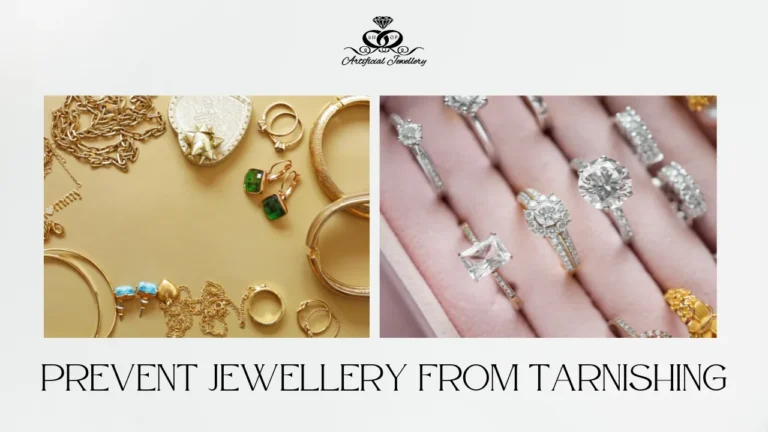Jhumkas have been an integral part of Indian jewellery for centuries, tracing their origins to ancient temple art and royal adornments. These bell-shaped earrings have evolved from being sacred ornaments to becoming a fashion staple for women of all ages.
Today, jhumkas blend tradition with contemporary aesthetics, offering endless varieties from temple-inspired heavy designs to lightweight fusion styles perfect for modern wardrobes. Whether you’re a bride looking for the perfect wedding jewellery or a college student wanting to elevate your ethnic look, there’s a jhumka design crafted just for you.
Traditional Types of Jhumkas
1. Temple Jhumkas
Inspired by the intricate carvings of South Indian temples, these jhumkas feature divine motifs of gods, goddesses, and floral patterns. Typically crafted in gold or gold-plated silver, temple jhumkas are substantial in weight and make a bold statement. They pair beautifully with Kanjeevaram silk sarees for weddings or religious ceremonies. The detailed craftsmanship often includes repoussé work where designs are hammered into the metal from the reverse side to create a 3D effect.
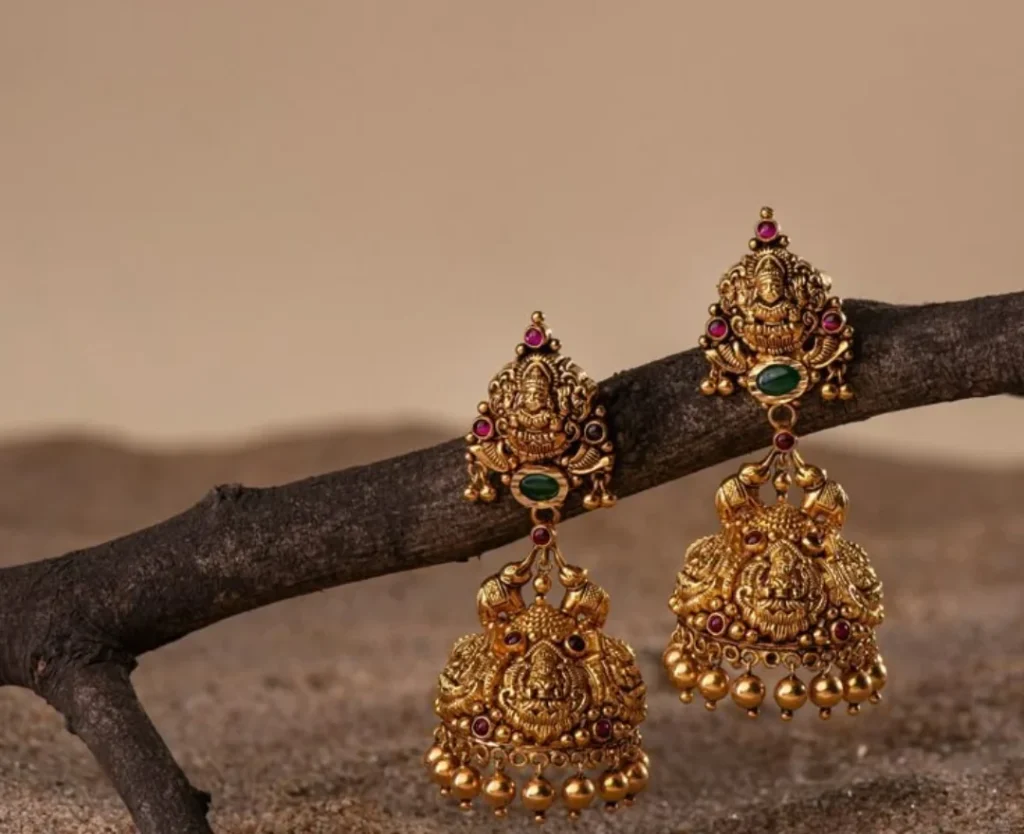
2. Kundan Jhumkas
Originating from the royal courts of Rajasthan, Kundan jhumkas showcase elaborate gemstone arrangements set in gold foil. The stones are typically uncut (polki) or glass, arranged in floral or geometric patterns. These jhumkas are heavier and often part of bridal sets, designed to complement Kundan necklaces and maang tikkas. Their vintage charm makes them perfect for traditional weddings and festive occasions where you want to make a regal impression.

3. Meenakari Jhumkas
Meenakari work involves enameling metal with vibrant colors, creating stunning visual depth. These jhumkas often feature a gold base with intricate floral patterns filled with bright red, green, and blue enamels. Lightweight yet eye-catching, they’re ideal for pre-wedding functions like haldi and mehndi. The artistry behind Meenakari involves multiple firings in a kiln to set each color separately, making every piece unique.
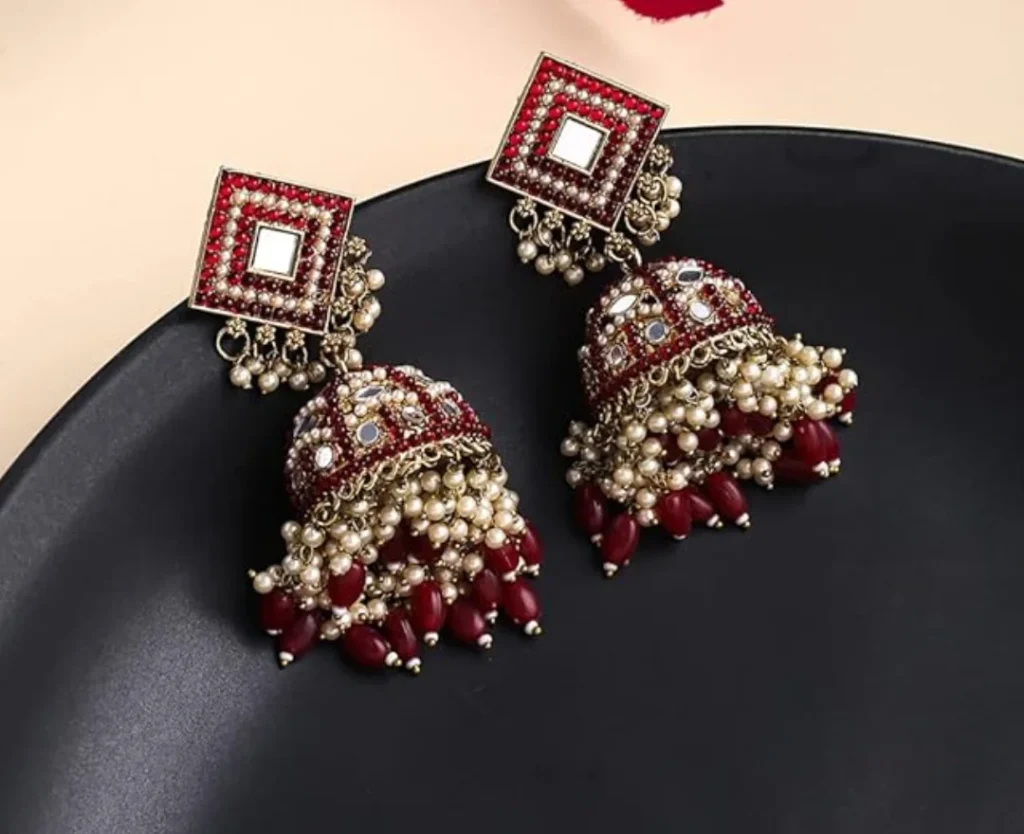
4. Polki Jhumkas
Polki jhumkas feature uncut diamonds set in gold, offering understated elegance with timeless appeal. Unlike the colorful vibrancy of Kundan, Polki focuses on the natural sparkle of diamonds in minimalist settings. These jhumkas work wonderfully for receptions and cocktail events where you want sophistication without overwhelming sparkle. The diamonds are typically rose-cut to maximize their brilliance while maintaining an organic, imperfect beauty.
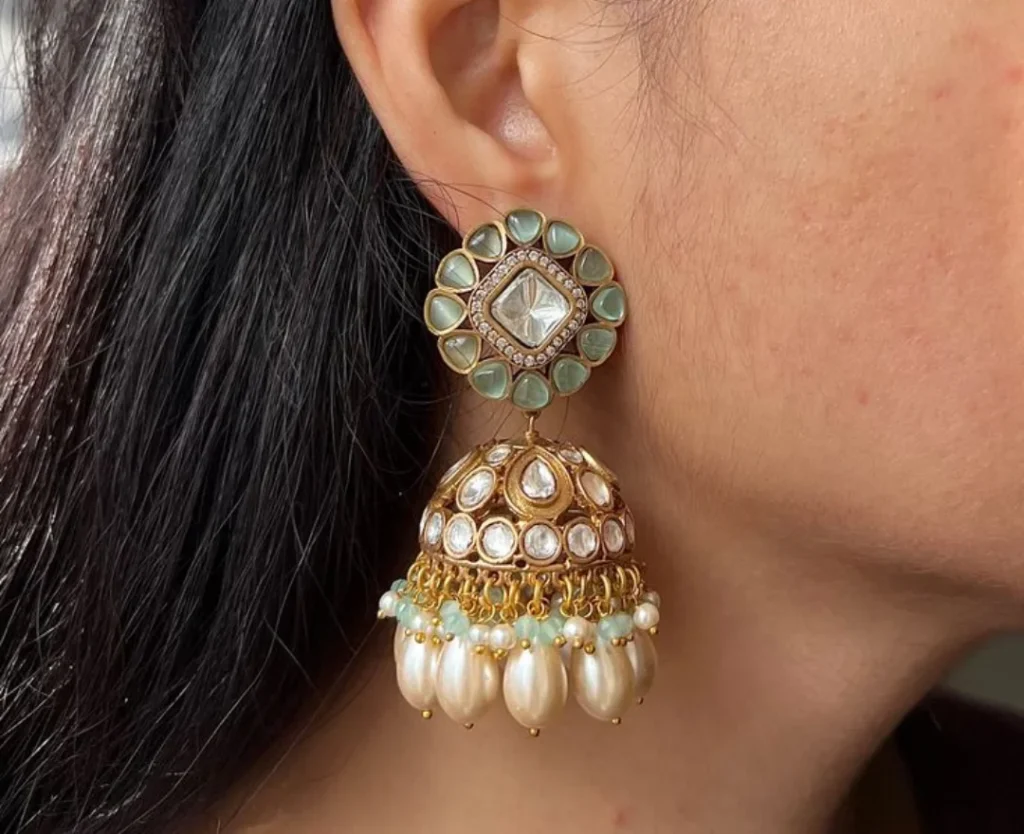
Want to explore more stunning jewellery styles? Check out our Detailed Guide on Types of Artificial Jewellery to discover everything from statement necklaces to trendy bracelets.
Modern & Fusion Jhumka Types
5. Hoop Jhumkas
A contemporary twist on traditional designs, hoop jhumkas combine circular hoops with dangling elements. These versatile pieces transition effortlessly from day to night – pair small gold hoops with minimal jhumka detailing for office wear, or choose larger, embellished versions for parties. The design cleverly merges Western hoop earrings with Indian jhumka silhouettes, making them perfect for Indo-western outfits like draped saree gowns or contemporary lehenga styles.
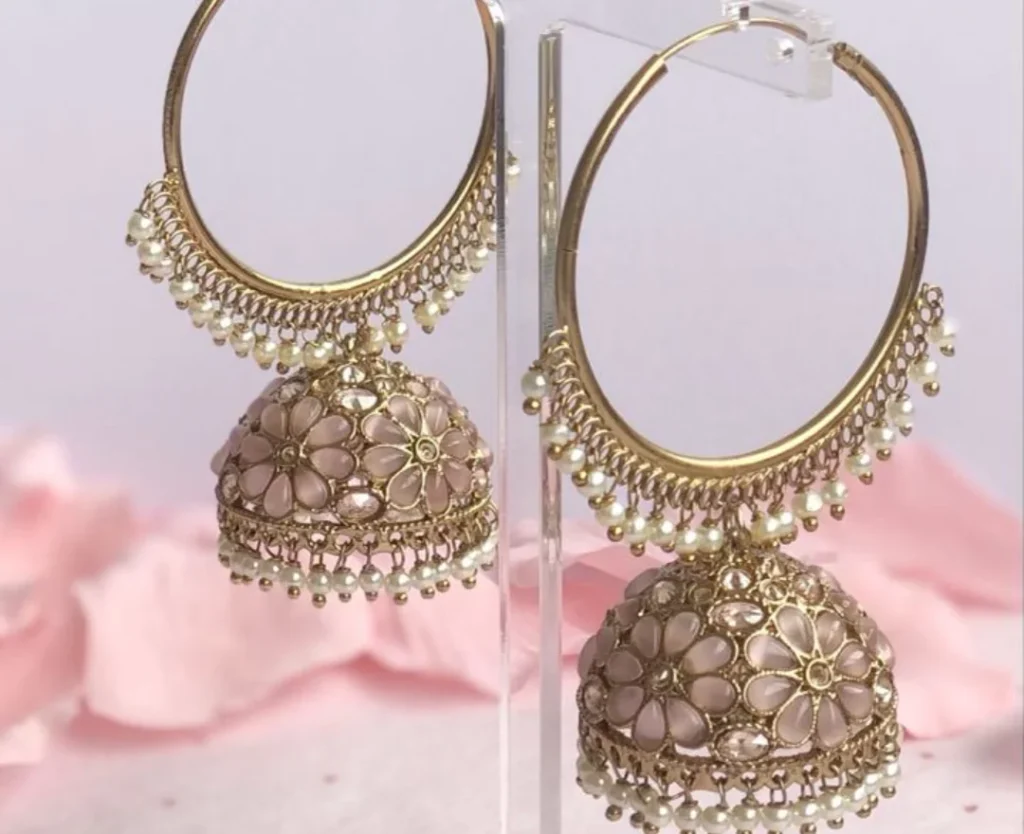
6. Ear-Cuff Jhumkas
For those who want drama without piercings, ear-cuff jhumkas are a game-changer. These innovative designs wrap around the ear’s cartilage, often extending into dangling elements that mimic traditional jhumkas. Ideal for sangeet nights or destination weddings, they create the illusion of multiple ear piercings while remaining comfortable. Look for designs with adjustable screws for a secure fit that won’t slip during dancing.
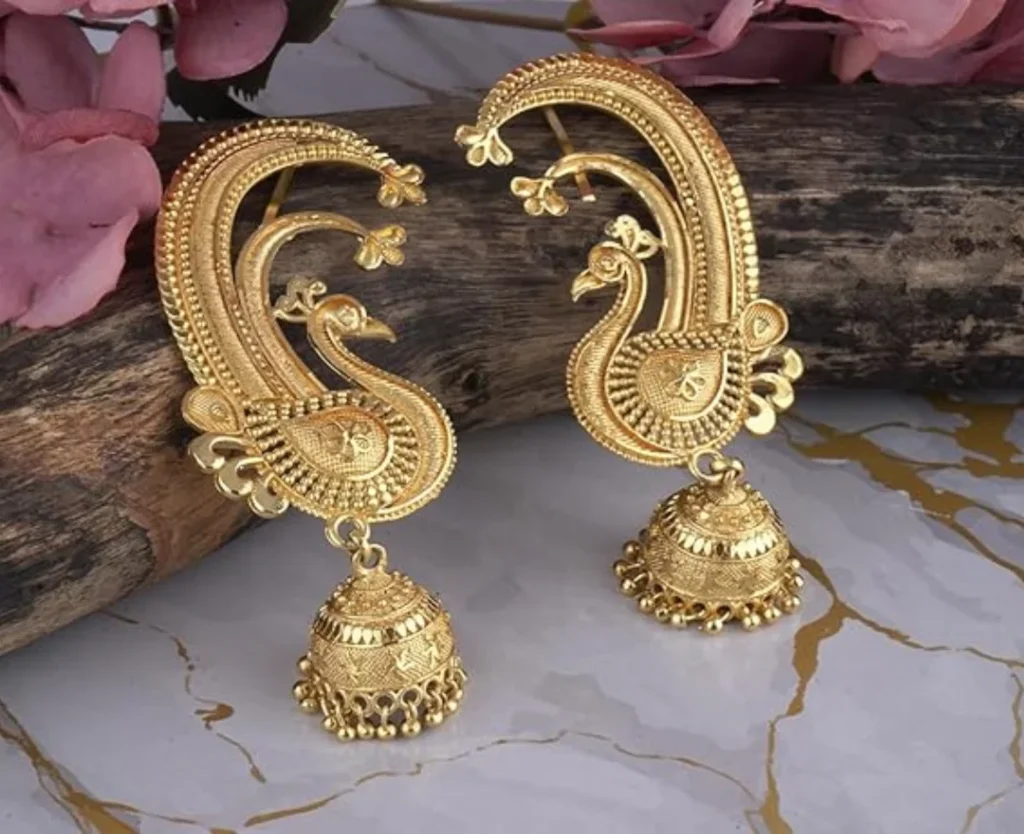
7. Thread Jhumkas
Handcrafted using colorful silk threads, beads, and sometimes small mirrors, thread jhumkas offer a bohemian vibe. Artisans from regions like Gujarat and Rajasthan create these lightweight pieces using traditional embroidery techniques. Perfect for college festivals or casual ethnic wear, they add a pop of color to simple Kurtis without weighing down your ears. The thread work allows for vibrant color combinations that can be matched to your outfit.
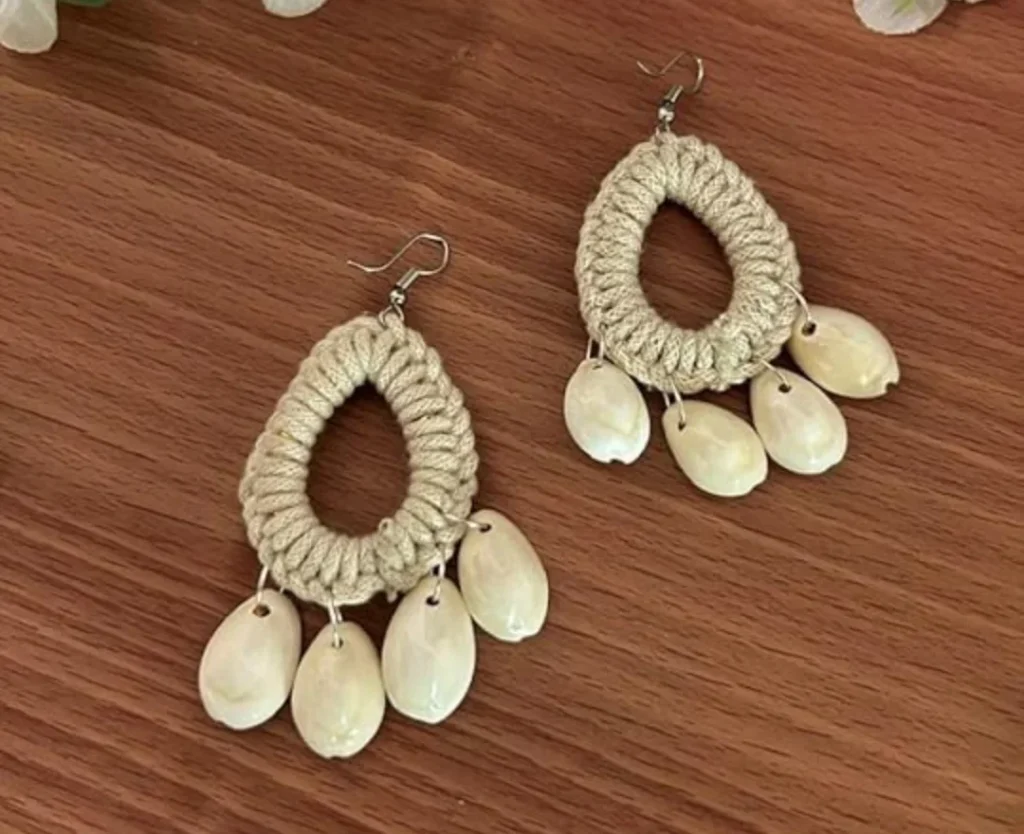
8. Chandbali-Jhumka Hybrids
This fusion design combines the crescent moon shape of Chandbalis with the bell structure of jhumkas. The result is a majestic yet balanced earring that offers grandeur without excessive weight. Modern versions often feature openwork designs in gold or silver, sometimes accented with pearls or small gemstones. These work exceptionally well with contemporary bridal wear like cape blouses or high-neck lehengas, providing a royal touch without looking outdated.
Wondering what makes jhumkas different from regular earrings? While all jhumkas are earrings, not all earrings are jhumkas! These iconic bell-shaped beauties with their signature jingle stand apart from other Indian earring styles like studs, hoops, or chandbalis. Our guide on types of Indian earrings breaks down these dazzling differences so you can spot and shop each style like a pro!
Material-Based Classification of Jhumkas
Gold-Plated Jhumkas
Gold-plated jhumkas offer the luxurious look of gold at a fraction of the price. The plating thickness (measured in microns) determines durability – look for at least 2.5 microns for long-lasting wear. These work well for daily office wear when chosen in smaller sizes, or for weddings when opting for heavier designs. Proper care involves storing them separately to prevent scratching and avoiding contact with perfumes.
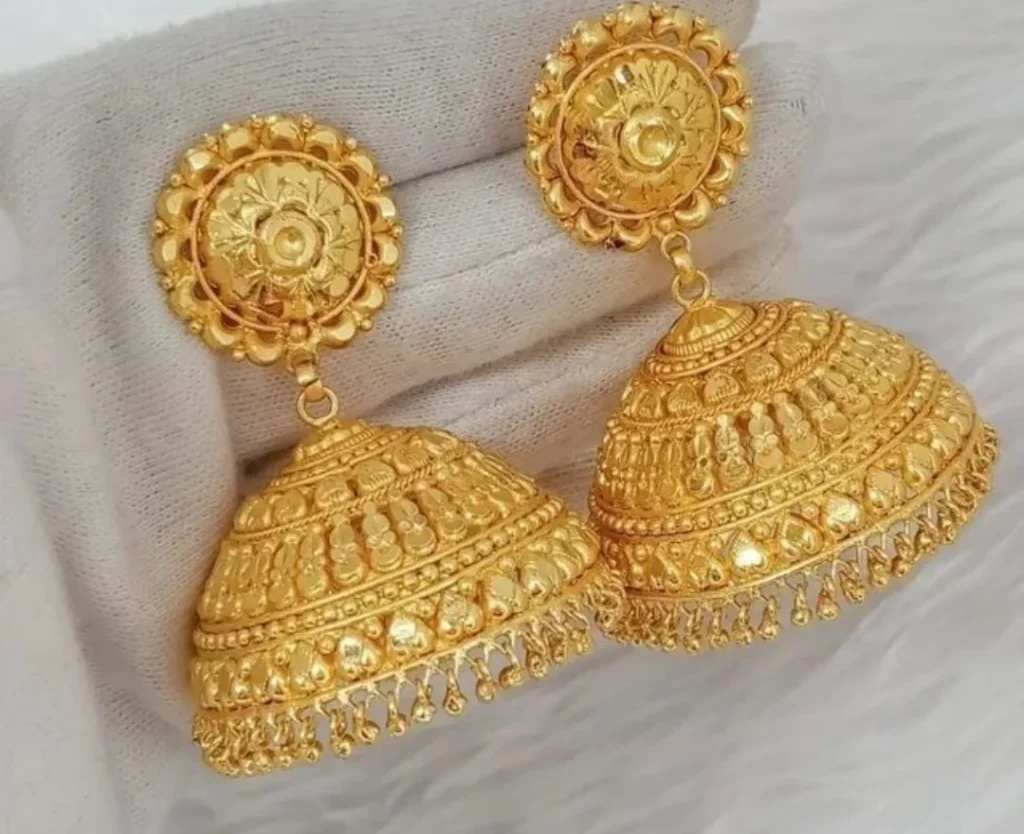
Silver Oxidised Jhumkas
Oxidized silver jhumkas have a distinctive antique look, with darkened crevices that highlight the intricate designs. This finish gives a vintage, earthy vibe perfect for bohemian or fusion outfits. The oxidation process actually strengthens the silver, making these jhumkas more durable than polished silver. They pair beautifully with pastel or white outfits, creating an elegant contrast.

Pearl Jhumkas
Pearl jhumkas range from simple single-pearl designs to elaborate clusters. South Indian pearl jhumkas often feature rows of pearls with gold accents, while contemporary versions might mix pearls with diamonds or colored stones. Pearls add a touch of sophistication suitable for both daytime events and evening weddings. Their neutral tone makes them versatile enough to match multiple outfits.
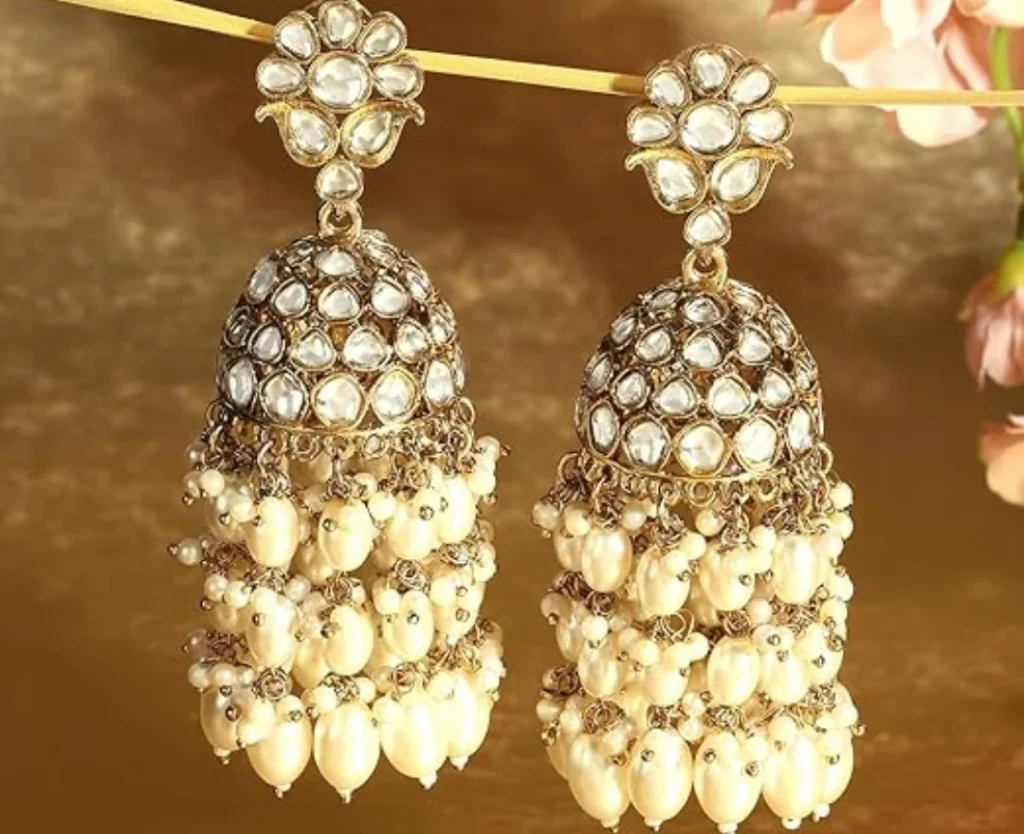
Mirror Work Jhumkas
Originating from tribal jewelry traditions, these jhumkas incorporate small circular mirrors surrounded by colorful thread or metalwork. The mirrors are believed to ward off evil while adding playful sparkle. Lightweight and eye-catching, they’re perfect for festivals like Navratri or casual ethnic wear. Modern interpretations use cut-glass mirrors for more refined sparkle.
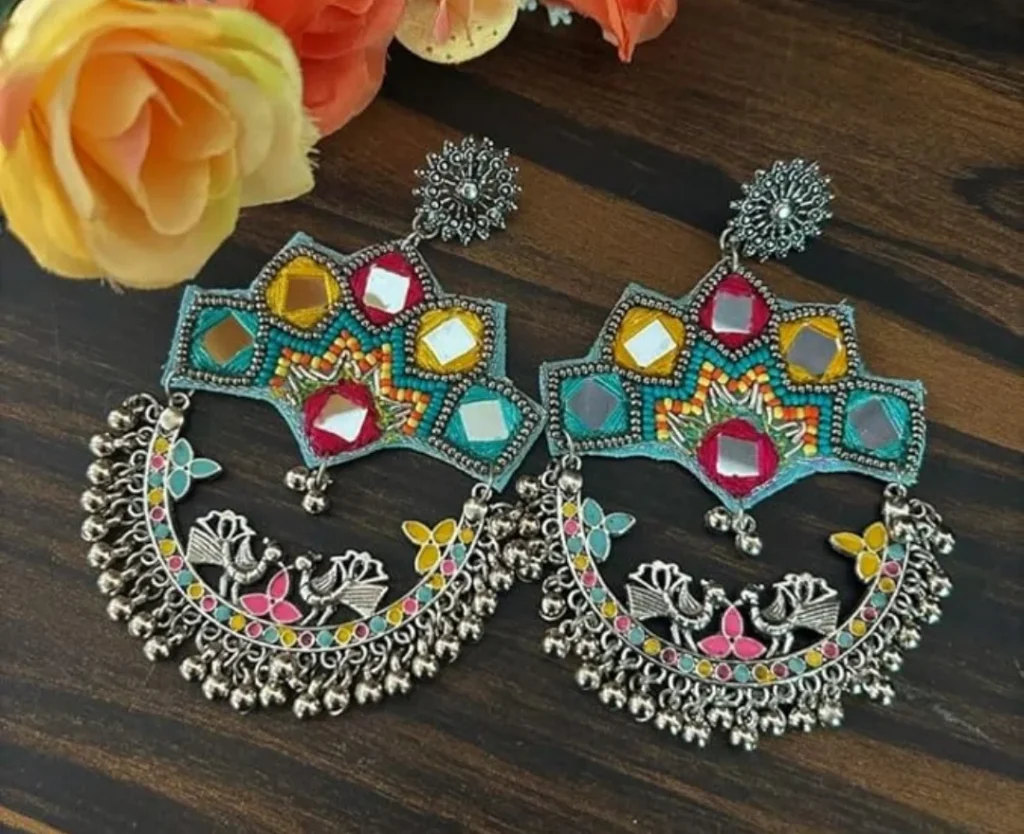
Terracotta or Clay Jhumkas
Handmade from baked clay, these jhumkas showcase India’s folk art traditions. Artisans paint intricate patterns using natural pigments, making each piece unique. Extremely lightweight and affordable, they’re ideal for college-goers or as vacation jewelry. The porous nature means they should be kept away from water and moisture to prevent damage.
Styling Tips for Different Face Shapes
Round Face
Longer jhumkas with angular designs help elongate the face. Try dagger-shaped drops or rectangular patterns that create vertical lines. Avoid small, round jhumkas that emphasize facial roundness. Medium-sized designs with some width at the bottom balance proportions beautifully.
Oval Face
Lucky oval-faced women can pull off almost any jhumka style. Experiment with dramatic oversized designs or delicate miniature versions. Asymmetrical or geometric jhumkas look particularly striking, playing up your natural balance.
Square Face
Soften angular jawlines with curved, circular, or teardrop-shaped jhumkas. Designs with rounded edges and floral motifs work wonders. Medium-length drops that end just below the jawline create the most flattering effect.
Heart-Shaped Face
Balance a wider forehead with jhumkas that have visual weight at the bottom. Bell-shaped designs or those with wider bases draw attention downward. Avoid overly top-heavy designs that might exaggerate facial proportions.
What to Pair Jhumkas With?
Sarees
Traditional silk sarees call for classic gold temple jhumkas or Kundan sets. For modern chiffon or georgette sarees, try lightweight pearl or polki jhumkas. The rule of thumb – heavier the saree, more substantial the jhumkas can be.
Lehengas
Bridal lehengas pair best with matching Kundan or Polki jhumkas from your jewelry set. For lighter lehengas, consider Meenakari or Chandbali hybrids that add color without overwhelming.
Kurtis & Anarkalis
Shorter kurtis work well with small to medium hoop jhumkas, while long Anarkalis can handle more dramatic designs. Match the jhumka’s formality to your outfit’s embellishment level.
Indo-Western Dresses
Contemporary gowns or dhoti sarees look stunning with ear-cuff jhumkas or minimalist gold designs. The key is balancing Western silhouettes with just the right amount of traditional detail.
Where to Wear What? (Occasion-Based Guide)
Weddings & Festive Functions
Go bold with Kundan, Polki, or Jadau jhumkas that match your jewelry set. Ensure they’re comfortable enough for long wear – test them during trials.
Office Parties or College Events
Choose lightweight gold-plated or silver jhumkas in smaller sizes. Thread or minimalist designs keep things professional yet stylish.
Casual Daywear
Tiny gold jhumkas or colorful terracotta pieces add ethnic flair without being over-the-top. Perfect for brunches or shopping outings.
Ethnic Day at Work or School
Medium-sized pearl or oxidized silver jhumkas strike the right balance between traditional and appropriate. Avoid anything too dangling or noisy.
Care Tips for Long-Lasting Shine
- Storage: Keep in individual soft pouches or compartments to prevent scratching. Anti-tarnish strips help preserve metal finishes.
- Cleaning: Use a soft toothbrush with mild soap water for metal jhumkas. For pearls or delicate materials, dry wiping suffices.
- Maintenance: Remove before swimming, showering, or applying beauty products. Check clasps and joints periodically for loose parts.
FAQs
Are jhumkas suitable for daily wear?
Absolutely! Opt for lightweight, smaller designs in gold-plated or silver for everyday comfort.
Why do girls love jhumka?
Girls love jhumkas because they effortlessly blend tradition with elegance, adding instant grace to any ethnic outfit. Their timeless charm and versatility—from delicate daily wear to grand bridal styles—make them a jewelry staple for every Indian woman.
Which type of jhumka is best?
The best type of jhumka depends on your outfit, face shape, and occasion:
– For brides & weddings: Heavy Kundan or Polki jhumkas for regal elegance.
– Daily wear: Lightweight hoop jhumkas or pearl-studded designs for comfort and subtle glam.
– Festive fusion: Meenakari or Chandbali-jhumka hybrids for vibrant, eye-catching style.
Pro tip: Match the jhumka’s weight and size to your outfit’s neckline for a balanced look! 😊
Can we wear jhumka on jeans?
Yes! Pair small, lightweight jhumkas with a fitted kurta or crop top and jeans for a chic Indo-western look. Opt for oxidized silver or gold-plated designs to balance ethnic charm with casual coolness. 😊
What is the other name for jhumka?
Jhumkas are also commonly known as:
– Chandbalis (when featuring a crescent-moon shape)
– Jhumkis (a regional variation of the name)
These traditional Indian bell-shaped earrings are sometimes called “danglers” in Western fashion contexts. 😊
Fun fact: In South India, temple-style jhumkas are often referred to as “Lakshmi earrings” due to their divine motifs.
Conclusion
From temple traditions to runway trends, jhumkas have gracefully adapted through centuries while retaining their cultural essence. Whether you’re drawn to the regal grandeur of Kundan sets or the contemporary charm of fusion designs, there’s a perfect pair waiting to adorn your ears. Remember, the best jhumkas are those that make you feel confident and connected to your personal style. Explore, experiment, and let your jhumkas tell your unique story!

